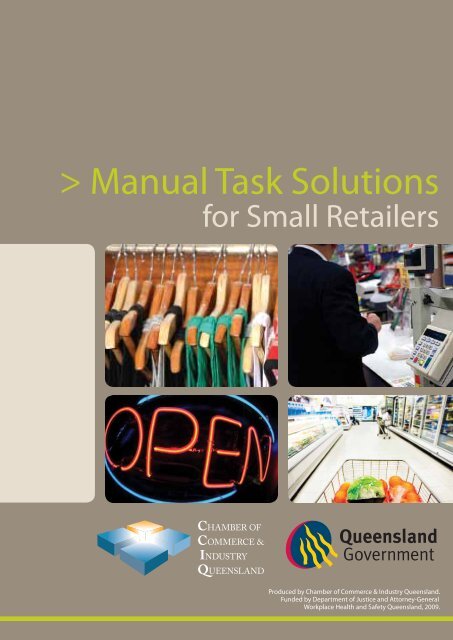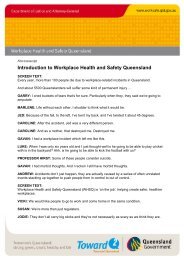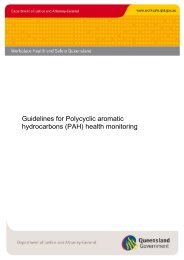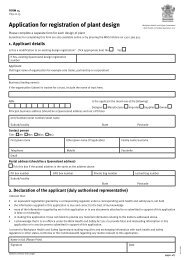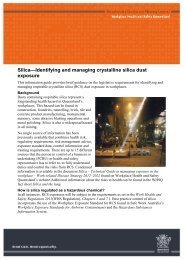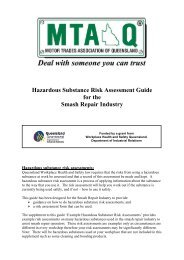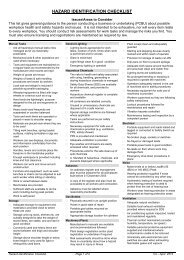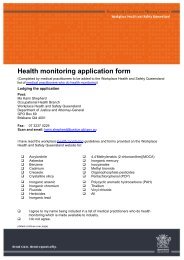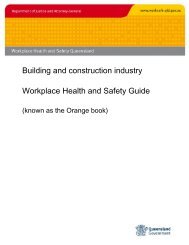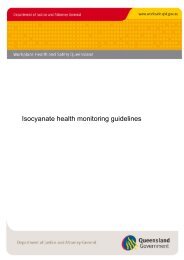Manual task solutions for small retailers (PDF, 1.17
Manual task solutions for small retailers (PDF, 1.17
Manual task solutions for small retailers (PDF, 1.17
Create successful ePaper yourself
Turn your PDF publications into a flip-book with our unique Google optimized e-Paper software.
<strong>Manual</strong> Task Solutions<br />
<strong>for</strong> Small Retailers<br />
Produced by Chamber of Commerce & Industry Queensland.<br />
Funded by Department of Justice and Attorney-General<br />
Workplace Health and Safety Queensland, 2009.
2<br />
Chamber of Commerce & Industry Queensland would like to thank Colorado Group, Zelows Travelgoods and Handbags and<br />
The Natural Foodstore <strong>for</strong> their assistance in the development and preparation of this resource.<br />
> Disclaimer<br />
The in<strong>for</strong>mation provided in this resource is distributed as an in<strong>for</strong>mation source only, and neither represents nor is intended to be advice on any particular matter.<br />
The in<strong>for</strong>mation is provided solely on the basis that readers will be responsible <strong>for</strong> making their own assessment of the matters discussed herein. No person should act<br />
specifically on the basis of the material herein without considering and taking professional advice. For specific in<strong>for</strong>mation on matters discussed in this resource please<br />
refer to the Workplace Health and Safety Act 1995.<br />
Whilst every care has been taken in preparing this publication, Chamber of Commerce & Industry Queensland, including its directors, servants and agents, will not accept<br />
any responsibility or liability to any person or corporation seeking to rely on any in<strong>for</strong>mation, advice, or opinion provided in this publication or otherwise given in any<br />
matter by the directors, servants or agents of Chamber of Commerce & Industry Queensland <strong>for</strong> any loss or damage of whatever nature suffered by any such person or<br />
corporation.
Table of<br />
Contents<br />
Introduction<br />
> What are strain and sprain injuries?<br />
How do strain and sprain injuries occur?<br />
<strong>Manual</strong> Tasks<br />
> How are hazardous manual <strong>task</strong>s managed?<br />
Control Options<br />
> Design Controls<br />
> Administrative Controls<br />
Hazard 1: Work above shoulder height<br />
> Solutions<br />
Hazard 2: Work below knee height<br />
> Solutions<br />
Hazard 3: Handling large, bulky and heavy stock items<br />
> Solutions<br />
Hazard 4: Using unsuitable materials handling equipment (MHE)<br />
> Solutions<br />
Hazard 5: Multiple handling of stock<br />
> Solutions<br />
Hazard 6: Point of sale<br />
> Solutions<br />
Hazard 7: Using ladders and steps<br />
> Solutions<br />
Hazard 8: Moving displays, racks, fixtures and fittings<br />
> Solutions<br />
Hazard 9: Sustained standing<br />
> Solutions<br />
Hazard 10: Peak times of the year<br />
> Solutions<br />
Useful Contacts & Further In<strong>for</strong>mation<br />
4<br />
4<br />
5<br />
6<br />
6<br />
7<br />
7<br />
7<br />
8<br />
9<br />
10<br />
11<br />
12<br />
13<br />
14<br />
15<br />
16<br />
16<br />
17<br />
17<br />
18<br />
19<br />
20<br />
20<br />
21<br />
21<br />
22<br />
22<br />
23<br />
3
Introduction<br />
Strain and sprain injuries are the single most frequent injury type <strong>for</strong> which<br />
workers’ compensation claims are made in Queensland.<br />
According to the Workplace Health and Safety Queensland Retail and Wholesale<br />
Industry Statistical Update 2005-06, manual <strong>task</strong>s are the main contributor to<br />
sprain and strain injuries and present a major hazard in retail.<br />
The nature of work<br />
per<strong>for</strong>med in the<br />
retail industry<br />
presents a number<br />
of challenges that<br />
can contribute to<br />
strain and sprain<br />
injuries.<br />
For example, stock<br />
is often handled<br />
many times from<br />
receipt to point of<br />
sale which results in<br />
repetitive body<br />
stressing.<br />
Storage space in<br />
stockrooms is<br />
usually kept to a<br />
minimum to<br />
maximise the size of<br />
the trading floor.<br />
This often results in<br />
stock being stored<br />
? Did you know?<br />
4<br />
in every possible<br />
metre of available<br />
space, including<br />
areas with awkward<br />
access and above<br />
shoulder height<br />
locations and areas<br />
requiring multiple<br />
movements to<br />
access stock, which<br />
encourages risk<br />
taking behaviour.<br />
This resource will<br />
describe 10 of the<br />
most common<br />
manual <strong>task</strong> hazards<br />
in retail and provide<br />
practical and cost<br />
effective <strong>solutions</strong><br />
to manage these<br />
hazards.<br />
What are strain and sprain injuries?<br />
Strain and sprain injuries are injuries of the<br />
musculoskeletal system.<br />
A strain is an injury to a muscle or tendon due to<br />
body stressing, whereas a sprain is a traumatic<br />
stretching or tearing injury to a ligament or joint<br />
capsule.<br />
> Strain and sprain injuries accounted <strong>for</strong> 63% of workers’ compensation claims<br />
> A third of injuries are to the lower back, 14% to the shoulder and 10% to the knee<br />
> Lifting, carrying or putting down objects causes 41% of injuries<br />
> Another 19% of injuries are due to handling objects and 14% are as a result of falls on the same level
How do strain and sprain<br />
injuries occur?<br />
Strains and sprains occur<br />
when the body’s tissues are<br />
stressed beyond their ability to<br />
withstand the stress.<br />
Sprain injuries often occur<br />
from a single traumatic<br />
incident such as rolling an<br />
ankle. Strain injuries however,<br />
generally occur from repeated<br />
body stressing over a period<br />
of time and include injuries to<br />
the lower back, shoulder and<br />
knee.<br />
There are three main types of<br />
risk factors that contribute<br />
to the development of strain<br />
and sprain injuries. Direct<br />
stressors are the factors which<br />
directly stress the body. When<br />
one or more of the direct<br />
stressors are present, the <strong>task</strong><br />
is a hazardous manual <strong>task</strong>.<br />
Whether direct stressors are<br />
present or not depends on<br />
the demands and nature of<br />
the <strong>task</strong> which is influenced<br />
by contributing risk factors.<br />
For example, a <strong>task</strong> may<br />
require workers to exert<br />
high <strong>for</strong>ce (direct stressor)<br />
to handle stock due to the<br />
size and weight of the carton<br />
(contributing risk factor).<br />
The third class of risk factors<br />
are modifying risk factors,<br />
which can influence the<br />
impact of other risk factors.<br />
For example, insufficient<br />
staffing levels can lead to an<br />
increase in the duration and<br />
frequency of a manual <strong>task</strong>.<br />
> Main Risk Factors<br />
As per the Workplace Health and Safety Queensland <strong>Manual</strong> Tasks<br />
Code of Practice 2000<br />
Risk Factor Description Retail Examples<br />
Direct Stressors: Stressors that directly stress the body<br />
Forceful Exertion Exerting high <strong>for</strong>ce and rapid movements > Handling heavy master cartons which<br />
to lift, hold, carry or move loads.<br />
are awkward and difficult to grip<br />
com<strong>for</strong>tably.<br />
Working Postures Awkward postures and/or static postures:<br />
> Awkward postures are those where a<br />
joint or joints are not in their normal<br />
position.<br />
> A static posture is where muscular<br />
<strong>for</strong>ce is required to hold joints in a<br />
fixed position <strong>for</strong> a sustained period<br />
of time.<br />
Duration The amount of time exposed to risk factors<br />
without a break or rotation of <strong>task</strong>s.<br />
Repetition Making the same movement over and over.<br />
> Reaching above shoulder height to<br />
handle stock on shelves.<br />
> Unpacking cartons from closely placed<br />
pallets.<br />
> Stretching out to reach over stock<br />
stored on the floor due to poor<br />
housekeeping.<br />
> Extended trading hours <strong>for</strong> special<br />
events such as Christmas.<br />
> Extended period of time working<br />
alone.<br />
> Scanning stock items at point of sale.<br />
> Breaking down and packing stock onto<br />
display shelving.<br />
Contributing Risk Factors: Factors that directly influence the <strong>task</strong> demands<br />
Work Area Design The positioning of different elements<br />
of the work area, such as work heights,<br />
dictate the postures used and the <strong>for</strong>ce<br />
exerted.<br />
Hand Tool Use Types of hand tools influence upper limb<br />
postures and static muscular ef<strong>for</strong>ts.<br />
Nature of Loads Relates to the size, shape and stability of<br />
loads.<br />
Load Handling Relates to the transfer of loads in the<br />
workplace.<br />
Modifying Risk Factors: Can influence the impact of other risk factors<br />
Individual Factors Relates to the skills and experience, work<br />
fitness and physical characteristics of the<br />
people per<strong>for</strong>ming the <strong>task</strong>.<br />
Work Organisation Work organisation factors can intensify<br />
<strong>task</strong> demands by increasing the duration<br />
of exposure, increasing the frequency the<br />
<strong>task</strong> is per<strong>for</strong>med, and/or reducing recovery<br />
time.<br />
> Limited size stock room results in<br />
stock stored above shoulder height or<br />
in areas that are difficult to access.<br />
> Using hand held scanners.<br />
> Flat pack furniture is often heavy,<br />
large and asymmetrical.<br />
> Stock that is heavy and awkward to<br />
grip, such as containers holding 10-20<br />
litres of liquids, bags of pool salt, etc.<br />
> Multiple handling of stock items from<br />
receipt to point of sale – the same<br />
stock may be handled at least three<br />
times.<br />
> Workers’ age, fitness, strength and<br />
height.<br />
> Whether workers are ‘work hardened’.<br />
> Where there are too few staff <strong>for</strong> the<br />
load demands.<br />
5
6<br />
> <strong>Manual</strong> Tasks<br />
A manual <strong>task</strong> is any activity where a person is required to exert <strong>for</strong>ce to lift,<br />
lower, push, pull, carry or otherwise move, hold or restrain any object.<br />
> How are hazardous manual <strong>task</strong>s managed?<br />
The best way to manage<br />
hazardous manual <strong>task</strong>s is by<br />
adopting a risk management<br />
approach.<br />
The <strong>Manual</strong> Tasks Code of<br />
Practice 2000 describes the<br />
risk management process as<br />
follows:<br />
1 > Risk Identification<br />
Identify the problem jobs<br />
which need investigating.<br />
Not all manual <strong>task</strong>s are<br />
hazardous. <strong>Manual</strong> <strong>task</strong>s are<br />
not hazardous if there are no<br />
direct stressors present.<br />
Actively encourage employees<br />
to identify hazardous manual<br />
handling <strong>task</strong>s.<br />
Problem jobs can be identified<br />
in a number of ways,<br />
including:<br />
> when changes are made to<br />
the workplace<br />
> by workers reporting<br />
discom<strong>for</strong>t or difficulties<br />
with a <strong>task</strong><br />
> if an injury occurs.<br />
2 > Risk Assessment<br />
Analyse the problem <strong>task</strong>s to<br />
identify which of the direct<br />
stressors are present and<br />
identify the contributing risk<br />
factors and modifying risk<br />
factors that are causing the<br />
direct stressors.<br />
Carefully observe the <strong>task</strong><br />
being per<strong>for</strong>med and talk to<br />
workers per<strong>for</strong>ming the <strong>task</strong>.<br />
The use of photographs and<br />
video are helpful to carefully<br />
study the <strong>task</strong>s.<br />
3 > Risk Control<br />
It is the contributing risk<br />
factors and modifying risk<br />
factors that need to be<br />
controlled because they cause<br />
the direct stressors.<br />
Consider all of the options to<br />
control the risk factor and<br />
select the best option<br />
available (see Control Options<br />
on the next page).<br />
Once you have selected the<br />
control options, put them in<br />
place and then review to make<br />
sure the control option is<br />
working as intended.
Control Options<br />
There are two main categories of risk controls <strong>for</strong> manual <strong>task</strong>s - design and<br />
administrative controls.<br />
> Design Controls<br />
Design controls involve the alteration of<br />
work processes or physical aspects of the<br />
workplace such as equipment and<br />
workstations.<br />
Design controls are preferred because they:<br />
> can eliminate or minimise exposure to<br />
the risk factors<br />
> are permanent<br />
> do not rely on human per<strong>for</strong>mance.<br />
There are two main types of design<br />
controls:<br />
1. Job Design/Redesign: Design of the<br />
work area, tools, equipment and loads<br />
being handled.<br />
2. Materials Handling Equipment (MHE):<br />
MHE reduces the muscular ef<strong>for</strong>t<br />
required to do the job. Examples of<br />
MHE includes trolleys, pallet jacks,<br />
conveyers and rollers.<br />
> Administrative Controls<br />
Administrative controls involve modifying existing personnel functions such as job rotation and<br />
rostering. Administrative controls are not as effective as design controls because they do not remove<br />
the risk factor, they only reduce exposure to the risk factor.<br />
In addition, administrative controls require ongoing supervision and may be <strong>for</strong>gotten during busy<br />
times because they rely on human per<strong>for</strong>mance.<br />
There are three main types of administrative controls:<br />
1. Work Organisation: Such as rotation of workers and smoothing of workflow peaks.<br />
Height of trolley floor raised to reduce<br />
trunk bending to access stock<br />
2. Task-specific Training: Training in work methods <strong>for</strong> specific <strong>task</strong>s such as handling methods and<br />
the use of tools and materials handling equipment (MHE).<br />
3. Preventative Maintenance Programs: By servicing and maintaining tools and equipment the ef<strong>for</strong>t<br />
required to operate them is reduced.<br />
7
8<br />
> Hazard 1:<br />
Work above shoulder height<br />
> Per<strong>for</strong>ming manual <strong>task</strong>s<br />
above shoulder height<br />
places the shoulders,<br />
neck and spine at risk of<br />
strain injury.<br />
> Handling stock above<br />
shoulder height is a high<br />
risk manual <strong>task</strong>. The<br />
risk is increased where<br />
the stock is heavy, the<br />
<strong>task</strong> is repeated<br />
frequently and/or the<br />
stock is handled above<br />
head height.<br />
> The risk of injury is also<br />
increased where high<br />
<strong>for</strong>ce is required to be<br />
exerted. High <strong>for</strong>ce<br />
activities can include<br />
opening cartons,<br />
breaking glue between<br />
cartons or freeing<br />
jammed stock.<br />
> Generally, <strong>retailers</strong> want<br />
to maximise their selling<br />
floor space and minimise<br />
the size of their storage<br />
space. This lack of<br />
storage room often<br />
results in <strong>retailers</strong> storing<br />
stock to the ceiling of<br />
the stock room. Workers<br />
may frequently have to<br />
reach well above their<br />
shoulders to access the<br />
stock and may also<br />
require a ladder to access<br />
the stock.<br />
> Retailers usually try to<br />
maximise the amount of<br />
space they have to<br />
display their stock on the<br />
trading floor. As such,<br />
they often display items<br />
almost to the ceiling of<br />
the trading floor.<br />
Workers may frequently<br />
have to reach above<br />
shoulder or even head<br />
height to access the<br />
stock.<br />
> When handling loads<br />
above shoulder height,<br />
the risk is increased<br />
further when the load is<br />
at arm’s reach away from<br />
the body.<br />
Examples of reaching above head<br />
height to access stock
*Solutions<br />
> Carefully plan the set<br />
up of the stockroom<br />
considering the nature<br />
of the stock carried<br />
as well as other items<br />
stored, such as fittings,<br />
promotional items and<br />
packaging materials:<br />
> Place highest volume<br />
lines and heaviest lines<br />
between knee and<br />
shoulder height.<br />
> Avoid storing items such<br />
as stock, fittings and<br />
packaging above head<br />
height where possible.<br />
> Place only light, compact,<br />
items that are rarely<br />
accessed, above shoulder<br />
height.<br />
> Position items on shelves<br />
above shoulder height at<br />
the front of the storage<br />
shelf to avoid over<br />
reaching to access stock.<br />
> Carefully plan the set<br />
up of the trading floor<br />
considering the nature of<br />
the stock carried:<br />
> Place the fastest moving<br />
lines between knee and<br />
shoulder height.<br />
> Place the light, slower<br />
moving lines above<br />
shoulder height and<br />
attach a sign asking<br />
customers to request<br />
assistance.<br />
> Use the area above<br />
head height <strong>for</strong> visual<br />
merchandising only.<br />
> Place dummy cartons<br />
(with the goods removed)<br />
on the top display shelves<br />
or use this space <strong>for</strong> visual<br />
merchandising only.<br />
> Use an industrial ladder<br />
to access items above<br />
shoulder height.<br />
> Label shelving and racks<br />
to indicate what stock is<br />
to be stored where.<br />
> Identify appropriate<br />
locations <strong>for</strong> the storage<br />
of fittings, promotional<br />
items and packaging, and<br />
ensure items are stored in<br />
the correct locations.<br />
> Review inventory levels to<br />
minimise stock on hand.<br />
> Carefully plan delivery<br />
times and days to receive<br />
stock when the stock<br />
room is least full.<br />
> Ensure the stockroom is<br />
tidy and ready to receive<br />
anticipated deliveries.<br />
> Set a maximum height<br />
at which items may be<br />
stored. Indicate this<br />
height with signage or by<br />
marking a line on the wall.<br />
> Adjust the height of<br />
stockroom storage shelves<br />
to allow <strong>for</strong> more storage<br />
below shoulder height.<br />
> Consider options to avoid<br />
the need to use ladders<br />
or steps, such as using a<br />
Using a step ladder to<br />
access stock<br />
Using a pole to access<br />
shoe boxes<br />
hook to access high stock.<br />
The hook must securely<br />
grip the stock to prevent<br />
the risk of stock falling<br />
from heights - test that the<br />
hook has securely gripped<br />
the stock be<strong>for</strong>e bringing it<br />
down.<br />
9
10<br />
> Hazard 2:<br />
Work below knee height<br />
> Frequently handling<br />
items where the hands<br />
are below knee height is<br />
defined as a high risk<br />
manual <strong>task</strong> due to the<br />
potentially awkward<br />
posture adopted to<br />
access the item.<br />
> The risk is further<br />
increased where<br />
handling items below<br />
knee height is per<strong>for</strong>med<br />
frequently, where heavy<br />
or bulky items are<br />
handled and/or where<br />
high <strong>for</strong>ce is exerted to<br />
handle the load.<br />
> High <strong>for</strong>ce may be<br />
exerted when per<strong>for</strong>ming<br />
such activities as:<br />
> removing packaging<br />
and stretch wrap from<br />
pallets<br />
> breaking glue to<br />
separate boxes or<br />
product<br />
> dragging heavy or<br />
sticking objects<br />
> opening boxes<br />
> reaching beyond arm’s<br />
length in order to pull<br />
or access objects stored<br />
below knee height.<br />
> Stock positioned on the<br />
floor of the stock room<br />
or trading floor requires<br />
workers to adopt poor<br />
posture to handle items<br />
below knee height.<br />
> Shelving above the stock<br />
may require workers to<br />
stoop or bend and<br />
possibly stretch<br />
awkwardly to reach<br />
items at the back.<br />
> Uneven, damaged<br />
shelving, flooring or<br />
pallet surfaces prevents<br />
stock from being easily<br />
slid <strong>for</strong>ward to the front<br />
be<strong>for</strong>e being picked up.<br />
> Displaying stock on the<br />
trading floor, such as<br />
building a floor stack,<br />
may require workers to<br />
per<strong>for</strong>m multiple <strong>task</strong>s<br />
below knee height.<br />
> Using a low trolley, such<br />
as a shopping trolley, to<br />
transport <strong>small</strong> items of<br />
stock will require work<br />
below knee height.<br />
Working with the hands below<br />
the knee height encourages<br />
awkward spinal postures
*Solutions<br />
> Store heavy and bulky lines above knee height and below shoulder height.<br />
> Reduce the frequency of handling items below knee height by avoiding storing high volume<br />
lines below knee height.<br />
> Raise the height at which stock is stored. For example, palletised stock can be raised on<br />
another pallet or on racking beams.<br />
> Improve access to stock stored at the rear by raising the height of shelving or racking<br />
beams above.<br />
> Use smooth surfaces such as ply wood to slide stock at the rear <strong>for</strong>ward.<br />
> Turn pallets of stock so that stock at the rear is brought to the front.<br />
> Leading practice is to use a height adjustable pallet lifter to raise the base of the pallet.<br />
For <strong>small</strong>er items and slower moving lines, use roller shelves on an incline to gravity feed<br />
product to the front of the shelf.<br />
> Where possible, when moving into new premises review storage areas and modify existing<br />
shelving to minimise work below knee height.<br />
Height of trolley floor<br />
raised to reduce trunk<br />
bending to access stock<br />
Optimum zone is between<br />
shoulder and knee height<br />
11
12<br />
> Hazard 3:<br />
Handling large, bulky and heavy stock items<br />
> Master cartons (outer<br />
cartons/shippers) that<br />
contain multiple units<br />
may be excessively heavy<br />
and/or bulky.<br />
> Stock items such as flat<br />
packs, furniture, white<br />
goods and hardware, are<br />
awkward to move due to<br />
their size and shape.<br />
This may lead to workers<br />
adopting awkward<br />
postures and/or exerting<br />
high <strong>for</strong>ce to handle the<br />
items.<br />
> Stock stored in bags or<br />
sacks, such as potting<br />
mix, pool chlorine or<br />
cement, are awkward to<br />
handle. The contents can<br />
move and the bag or<br />
sack may de<strong>for</strong>m,<br />
requiring high <strong>for</strong>ce to<br />
be exerted to handle the<br />
load. Bags and sacks can<br />
also be difficult to grasp.<br />
> Large, bulky items may<br />
be difficult to handle as<br />
the centre of gravity is<br />
off centre, requiring<br />
uneven <strong>for</strong>ce.<br />
> Handling items on<br />
trolleys, where the load<br />
weight exceeds the rated<br />
load of the trolley, may<br />
cause damage to the<br />
trolley and can require<br />
high <strong>for</strong>ce to move.<br />
> Where cartons of stock<br />
are not labelled or not<br />
accurately labelled with<br />
stock weight, there is no<br />
warning to workers<br />
be<strong>for</strong>e they commence<br />
handling the load.<br />
> Poor quality or damaged<br />
packaging can make the<br />
load unstable and<br />
difficult to handle.<br />
> Damaged or uneven<br />
flooring and/or shelving<br />
surfaces can require<br />
workers to lift heavy or<br />
bulky items, as the<br />
damage prevents them<br />
from being slid.<br />
> Large cartons repacked<br />
at the store can be<br />
packed with excessive<br />
weight.<br />
> Insufficient space in the<br />
stock room and on the<br />
trading floor may restrict<br />
the ability to manoeuvre<br />
large, bulky stock,<br />
resulting in high <strong>for</strong>ce<br />
required to manoeuvre<br />
the stock.<br />
Examples of heavy master cartons stacked<br />
above shoulder height by couriers
*Solutions<br />
> Advise the supplier of<br />
the maximum acceptable<br />
weight of master cartons.<br />
You may need to join<br />
<strong>for</strong>ces with like <strong>retailers</strong><br />
to request <strong>small</strong>er pack<br />
sizes from suppliers. The<br />
paint industry has recently<br />
successfully removed 20L<br />
paint containers, and wine<br />
makers are now supplying<br />
half dozen cartons.<br />
> Request that the supplier<br />
label the carton with the<br />
carton weight. In the<br />
short term, label or mark<br />
cartons with the weight on<br />
receipt.<br />
> Use materials handling<br />
equipment (MHE) that is<br />
fit <strong>for</strong> purpose to move<br />
stock, such as flat bed<br />
trolleys, two wheel trolleys<br />
or pallet jacks.<br />
> Advise delivery personnel<br />
where to place stock and<br />
stipulate maximum height<br />
<strong>for</strong> it to be stacked.<br />
> Consider opportunities <strong>for</strong><br />
displaying stock on the<br />
trading floor in the master<br />
carton or on pallets (such<br />
as terracotta pots).<br />
> Unpack heavy master<br />
cartons from the position<br />
in which they are received;<br />
that is, the floor, pallet or<br />
trolley, so that the heavy<br />
master carton does not<br />
need to be handled when<br />
full.<br />
> Team lifting is an option,<br />
but not without risk,<br />
and should only be used<br />
in circumstances where<br />
options <strong>for</strong> redesign or<br />
using mechanical aids<br />
have been investigated<br />
and are not practicable.<br />
> Handling of large, bulky<br />
or awkward items should<br />
ideally only occur between<br />
shoulder and knee height.<br />
> Design the stockroom<br />
to allow large, bulky or<br />
awkward items to be slid<br />
and trolleyed instead of<br />
carried. For example, store<br />
large, bulky items at the<br />
same height as the trolley<br />
and ensure the storage<br />
surface will allow the<br />
stock to slide.<br />
> Store heavy, bulky stock<br />
items between shoulder<br />
and knee height.<br />
> Provide adequate access to<br />
heavy, bulky stock items in<br />
the stock room to prevent<br />
awkward postures. For<br />
example, walk in pallet<br />
racking where the second<br />
level beam is more than<br />
1.8 metres in height.<br />
Use appropriate materials handling<br />
equipment (MHE) to move stock<br />
13
14<br />
> Hazard 4:<br />
Using unsuitable materials handling<br />
equipment (MHE)<br />
> Using shopping trolleys<br />
to store and move stock<br />
encourages excessive<br />
bending and reaching, as<br />
well as poor movement<br />
patterns.<br />
> Overloading MHE with<br />
stock weight that<br />
exceeds the safe working<br />
load of the MHE can<br />
damage the MHE and<br />
can require excessive<br />
<strong>for</strong>ce to handle.<br />
> Overloading MHE with<br />
stock so that the<br />
operator is unable to<br />
look in the direction of<br />
travel can encourage the<br />
operator to adopt<br />
awkward postures to<br />
improve visibility.<br />
> Poorly maintained MHE<br />
wheels and castors<br />
require workers to exert<br />
additional <strong>for</strong>ce to move<br />
or control the MHE. For<br />
example, packing<br />
material such as plastic<br />
wrap and string can get<br />
caught in wheels and<br />
castors.<br />
> Operating the MHE on<br />
rough, uneven or<br />
damaged floor surfaces<br />
requires the worker to<br />
exert additional <strong>for</strong>ce to<br />
move or control the<br />
MHE.<br />
> Incorrect MHE wheels <strong>for</strong><br />
the type of floor surface<br />
can lead to excessive<br />
wear of the wheels and<br />
can require additional<br />
<strong>for</strong>ce to be exerted.<br />
> Operating wheeled MHE<br />
on slopes or ramps<br />
requires the operator to<br />
exert additional <strong>for</strong>ce.<br />
> Use of powered MHE<br />
that the operator is not<br />
competent to operate<br />
can be hazardous.<br />
Poor trunk posture from bending<br />
into deep shopping trolley<br />
Damaged MHE wheels
*Solutions<br />
> When selecting materials handling equipment (MHE) consider:<br />
> the size and weight of the stock that needs to be moved<br />
> the maximum weight that the MHE will need to carry<br />
> where the stock is to be moved to and from<br />
> the type of surfaces the MHE will operate on<br />
> where the stock is to be stored, <strong>for</strong> example, will the stock be lifted into storage racks?<br />
> the amount of space available to manoeuvre the MHE<br />
> the amount of space available to store the MHE<br />
> the training and competency required to use the MHE.<br />
> Regularly inspect MHE <strong>for</strong> damage and wear.<br />
> Conduct preventative maintenance on MHE to ensure correct and safe operation.<br />
> Establish, communicate and rein<strong>for</strong>ce a process <strong>for</strong> staff to report damage and wear to<br />
MHE.<br />
> Consider trialing MHE be<strong>for</strong>e committing to purchase the equipment. Many MHE suppliers<br />
can provide MHE <strong>for</strong> short term trials.<br />
> Maintain a high level of housekeeping on the floor of the stock room and trading floor to<br />
prevent the MHE wheels and castors fouling on packing material on the floor.<br />
Top shelf suitable <strong>for</strong><br />
<strong>small</strong> items<br />
Flap trolleys suitable <strong>for</strong><br />
large stock items<br />
15
*<br />
Solutions<br />
16<br />
> Advise delivery personnel<br />
where to place stock and<br />
stipulate the maximum<br />
height <strong>for</strong> it to be stacked.<br />
> Review stock levels<br />
and lead times <strong>for</strong><br />
opportunities to reduce<br />
stock on hand stored<br />
in the stockroom and<br />
consider storing some<br />
lines on the trading<br />
floor only. Consider<br />
opportunities <strong>for</strong><br />
displaying stock on<br />
the trading floor in the<br />
master carton. This<br />
is often called retail<br />
> Hazard 5:<br />
Multiple handling of stock<br />
> Stock is frequently<br />
handled multiple times<br />
from the point of receipt<br />
at the store, to sale. As a<br />
minimum, stock is<br />
unpacked, stored in the<br />
stock room, placed on<br />
show, then handled at<br />
point of sale.<br />
> The risk is increased<br />
where:<br />
> the stock is heavy and/or<br />
large and bulky to handle<br />
> the stock is moved with<br />
ready packaging and<br />
is becoming popular in<br />
grocery retail.<br />
> Break up <strong>task</strong>s involving<br />
repetitive movements,<br />
such as stacking shelves,<br />
into <strong>small</strong>er <strong>task</strong>s and<br />
alternate the <strong>task</strong>s.<br />
> Plan the stockroom to<br />
avoid having to move<br />
stock to access the stock<br />
you need.<br />
> Design the point of sale<br />
area so that repetitive<br />
stock handling is<br />
conducted at waist height.<br />
the body in an awkward<br />
posture, such as above<br />
shoulder height or below<br />
knee level<br />
> high <strong>for</strong>ce is required to<br />
handle the item, such as<br />
to open cartons and free<br />
jammed stock.<br />
Examples of retail ready packaging<br />
on a pallet on the selling floor
Hazard 6:<br />
Point of sale<br />
> Handling of heavy stock<br />
lines at the register to<br />
scan the barcode.<br />
> Repetitive handling of<br />
stock to scan and bag.<br />
> Risk is increased where<br />
repetitive movements are<br />
per<strong>for</strong>med in awkward<br />
postures, such as over<br />
reaching to access stock.<br />
Hand held scanners allow heavy stock to<br />
be scanned without handling it<br />
*<br />
Solutions<br />
> Use scan cards or quick<br />
keys (pre-programmed<br />
into register) instead of<br />
lifting heavy, bulky items.<br />
> For multiple items, scan<br />
one item and then enter<br />
the number of units on<br />
the register.<br />
> Cut off barcode from<br />
item and scan barcode if<br />
possible.<br />
> Request that customers<br />
leave heavy items in the<br />
trolley and use handheld<br />
scanner to scan item in<br />
trolley.<br />
Repetitive handling of stock items at point of sale -<br />
due to the design of the workstation, the operator<br />
has to overreach to the side to access stock<br />
> Rotate point of sale<br />
operation with other<br />
duties within the store<br />
that use different parts of<br />
the body.<br />
> Design the layout of the<br />
point of sale workstation<br />
to eliminate the need<br />
<strong>for</strong> staff to overreach to<br />
handle stock.<br />
17
18<br />
> Hazard 7:<br />
Using ladders and steps<br />
> Using a ladder or step<br />
that does not have the<br />
load carrying capacity<br />
may damage and weaken<br />
the ladder. For example,<br />
using a ladder that is<br />
rated <strong>for</strong> domestic use<br />
only.<br />
> Workers not using<br />
ladders or steps, but are<br />
overreaching to access<br />
stock above shoulder<br />
height.<br />
> Inappropriate items used<br />
to gain height, such as<br />
climbing fixtures, using<br />
upside down milk crates,<br />
etc.<br />
> Stepping back from a<br />
ladder or step and<br />
twisting an ankle on<br />
stock or other items on<br />
the floor behind ladder.<br />
> Overreaching from top of<br />
ladder or step that is too<br />
short <strong>for</strong> purpose.<br />
> Insufficient space in<br />
stockroom and/or sales<br />
floor to use ladder or to<br />
use ladder opened<br />
correctly.<br />
> Using ladders or steps<br />
that are damaged and<br />
may fail whilst in<br />
operation.<br />
> When stock is carried by<br />
the worker as they step<br />
down from a ladder or<br />
step, the worker does not<br />
have three points of<br />
contact and is at risk of<br />
falling.<br />
Climbing fixtures to gain<br />
height is unsafe<br />
Insufficient space to open ladder fully
*Solutions<br />
> Ensure the condition<br />
of ladders and steps<br />
is regularly reviewed<br />
as part of the hazard<br />
identification checklist.<br />
> Select and obtain<br />
industrial rated ladders<br />
and steps that are fit <strong>for</strong><br />
purpose. Consider:<br />
> the height required to<br />
reach<br />
> the weight of both the<br />
average employee and the<br />
weight of objects being<br />
carried<br />
> the floor area available <strong>for</strong><br />
the base of the ladder or<br />
step<br />
> what the worker will be<br />
doing on the ladder or<br />
step<br />
> where the ladder or step<br />
will be stored.<br />
> Select ladders and steps<br />
that have a large standing<br />
plat<strong>for</strong>m at the top.<br />
> Maintain a high standard<br />
of housekeeping in the<br />
stockroom. This includes<br />
ensuring the stockroom<br />
floor is free from stock<br />
and packing material that<br />
could obstruct the ladder<br />
and/or obstruct a worker’s<br />
access to a ladder.<br />
> Remove items from the<br />
store room that may be<br />
used inappropriately to<br />
gain height, such as milk<br />
crates.<br />
> Train workers to use the<br />
ladder to access stock<br />
above shoulder height<br />
and then place the stock<br />
item on a lower shelf so<br />
that the worker can climb<br />
down without holding the<br />
stock.<br />
> Train workers on when to<br />
use the ladder or step and<br />
how to use them safely.<br />
> Supervise workers to<br />
ensure they use the ladder<br />
or step when and how<br />
they should.<br />
> Consider options to avoid<br />
the need to use ladders<br />
or steps, such as using<br />
a hook or pole to access<br />
high stock. The hook must<br />
securely grip the stock to<br />
prevent the risk of stock<br />
falling from heights.<br />
> Avoid per<strong>for</strong>ming work<br />
whilst up the ladder. For<br />
example, when dressing<br />
mannequins, they should<br />
be brought down to the<br />
floor and redressed first,<br />
and then taken back up.<br />
Ladder in use<br />
Using a pole to access<br />
shoe boxes<br />
19
Hazard 8:<br />
Moving displays, racks,<br />
fixtures and fittings<br />
> Heavy fixtures and<br />
displays are moved<br />
around the sales floor<br />
periodically. Excessive<br />
<strong>for</strong>ce may need to be<br />
exerted in awkward<br />
postures to move the<br />
fixtures and displays.<br />
> Mobile fixtures displaying<br />
stock may be moved in<br />
front of the store on<br />
opening, and moved back<br />
into the store at closing<br />
on a daily basis.<br />
*<br />
Solutions<br />
20<br />
> Avoid moving fixtures<br />
wherever possible.<br />
> Minimise the need to<br />
relay the store by carefully<br />
considering store layout at<br />
design stage.<br />
> Install castors on regularly<br />
moved fixtures and<br />
displays, such as those<br />
which are moved in<br />
front of the store during<br />
opening.<br />
> Select castors appropriate<br />
<strong>for</strong> the type of floor<br />
surface, and the size and<br />
> Injuries may occur when<br />
horizontal brackets<br />
become jammed in<br />
vertical strips.<br />
> Lacerations and strains<br />
may occur when glass<br />
fittings are being moved.<br />
> Wheeled displays with<br />
castors that are not<br />
maintained increase the<br />
risk of <strong>for</strong>ce required to<br />
be exerted to move the<br />
displays.<br />
weight of the mobile<br />
fixture.<br />
> Conduct periodic<br />
preventative maintenance<br />
on castors.<br />
> Establish a process and<br />
train workers to report<br />
when wheels or castors<br />
require servicing or repair.<br />
> Use materials handling<br />
equipment such as trolleys<br />
to move fixtures where<br />
possible.<br />
> Identify items that require<br />
more than one worker<br />
> Mannequins tend to be<br />
bottom heavy and can be<br />
very difficult to move whilst<br />
maintaining a neutral spinal<br />
posture.<br />
to move; communicate<br />
this requirement to all<br />
workers. Team lifting<br />
should only be used where<br />
design control measures<br />
are not possible.<br />
> Consider weight and size<br />
when selecting visual<br />
merchandising aids<br />
such as mannequins.<br />
Select light weight<br />
and/or modular visual<br />
merchandising aids<br />
wherever possible.
Hazard 9:<br />
Sustained standing<br />
> Workers experience aching legs and feet from sustained<br />
standing on hard floor surfaces.<br />
> Workers experience low back pain from standing <strong>for</strong><br />
long periods due to tendency to stand in a sway back<br />
posture.<br />
> Workers wearing inappropriate footwear especially in<br />
fashion retail, such as heels and slides. This choice of<br />
footwear can contribute to slips, trips and falls, as well<br />
as aching legs and feet and low back pain.<br />
*<br />
Solutions<br />
> Com<strong>for</strong>table footwear<br />
with a low heel should be<br />
worn.<br />
> Use anti-fatigue matting<br />
where possible, such as<br />
behind the checkout. Be<br />
aware that matting can<br />
be a trip hazard, so ensure<br />
the edges of the mat are<br />
bevelled and sit flat on the<br />
floor.<br />
> Rotate workers to avoid<br />
them having to stand in<br />
one spot <strong>for</strong> long periods.<br />
> Provide a stool <strong>for</strong> workers<br />
to sit down on <strong>for</strong> short<br />
periods when not serving<br />
customers.<br />
> Provide a horizontal bar<br />
or rail at the base of the<br />
counter <strong>for</strong> foot support,<br />
Horizontal bar/rail <strong>for</strong><br />
foot support eases back<br />
strain - <strong>Manual</strong> Tasks<br />
Code of Practice 2000<br />
Use anti-fatigue matting<br />
behind the counter<br />
Use anti-fatigue matting<br />
behind the counter<br />
tilting the hips and easing<br />
strain on the lower back.<br />
> Provide adequate<br />
amenities, including<br />
com<strong>for</strong>table seating<br />
<strong>for</strong> employees, during<br />
designated breaks.<br />
21
High volumes of stock restrict<br />
access in stock room<br />
*Solutions<br />
22<br />
> Consider options <strong>for</strong><br />
access to additional stock<br />
without having to store<br />
on-site, such as:<br />
> off-site storage of stock<br />
(most shopping centres<br />
hire off-site store rooms).<br />
Consider how the stock<br />
can be safely transported<br />
from the-off site storage<br />
facility to the store, <strong>for</strong><br />
example, using a trolley.<br />
> Hazard 10:<br />
Peak times of the year<br />
> For many <strong>retailers</strong>, there<br />
are seasonal peaks in<br />
trade such as Christmas,<br />
end of season sales,<br />
Easter, back to school,<br />
etc.<br />
> Increased amount of<br />
stock in stockroom and<br />
on sales floor can<br />
potentially result in:<br />
> an increase in the height<br />
at which stock is stored<br />
> reduced room to move<br />
safely and to use<br />
materials handing<br />
equipment and ladders.<br />
> Increased sale of stock<br />
results in workers<br />
> arranging additional<br />
deliveries of stock.<br />
> Plan stock deliveries <strong>for</strong><br />
the quietest time of the<br />
day or week to allow stock<br />
to be put away be<strong>for</strong>e<br />
peak trade times.<br />
> Consider hiring casual<br />
staff to cover longer<br />
trading hours and to cover<br />
peak times.<br />
handling a larger<br />
amount of stock per<br />
shift.<br />
> Workers may work<br />
longer hours during<br />
peak periods.<br />
> When busy, workers<br />
may tend to rush and<br />
cut corners.<br />
> High volumes of stock<br />
may be stored <strong>for</strong><br />
extended periods be<strong>for</strong>e<br />
the peak time to ensure<br />
stock arrives in time.<br />
> Ensure rostering<br />
appropriately matches<br />
peak trading times.<br />
> Implement a<br />
communication method,<br />
such as a book, that<br />
can be used to discuss<br />
impending deliveries,<br />
where stock should be<br />
stored and hazards that<br />
require attention.
Useful<br />
Contacts<br />
Workplace Health and Safety Queensland<br />
Infoline: 1300 369 915<br />
Web: www.worksafe.qld.gov.au<br />
Chamber of Commerce & Industry Queensland<br />
Phone: 07 3842 2244<br />
Email: whs@cciq.com.au<br />
Web: www.cciq.com.au<br />
> Further<br />
In<strong>for</strong>mation<br />
<strong>Manual</strong> Tasks Code of Practice: Workplace Health and Safety Queensland<br />
http://www.deir.qld.gov.au/workplace/law/codes/manual<strong>task</strong>s/index.htm<br />
A Guide to Handling Large, Bulky or Awkward Items: Worksafe Victoria<br />
http://www.worksafe.vic.gov.au/wps/wcm/connect/WorkSafe/Home/Forms+and+Publications/<br />
Publications/import_Large%2C+Bulky+or+Awkward+Items%2C+A+Guide+to+Handling<br />
Serious about Safe Business Pack: Workplace Health and Safety Queensland<br />
http://www.deir.qld.gov.au/workplace/business/<strong>small</strong>business/businesspack/index.htm<br />
A Guide to <strong>Manual</strong> Order Picking: Worksafe Victoria<br />
http://www.worksafe.vic.gov.au/wps/wcm/connect/WorkSafe/Home/Forms+and+Publications/<br />
Publications/import_<strong>Manual</strong>+Order+Picking%2C+A+Guide+to<br />
Small Business Program: Workplace Health and Safety Queensland<br />
http://www.deir.qld.gov.au/workplace/business/<strong>small</strong>business/index.htm<br />
23


